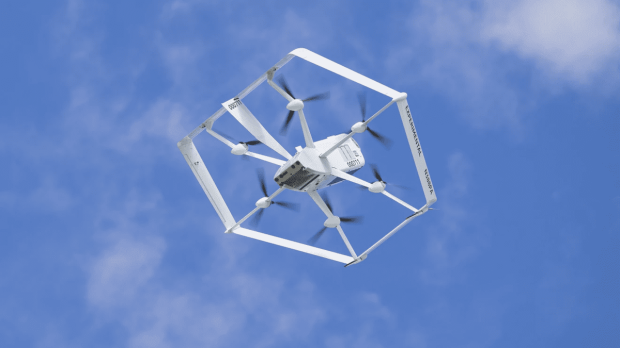Amazon Answers Walmart’s Drone Push With Limited Launch Later This Year

Three weeks after Walmart announced plans to offer drone delivery service to 4 million households in six states, rival Amazon is out with an aerial answer of its own, albeit on a much more limited scale and years behind schedule.
In a blog post published late Monday (June 13), Amazon said the initial Prime Air drone delivery service is not set to take flight until “later this year” and will be limited to customers in Lockeford, California, a rural community that sits about 90 miles west of San Francisco in San Joaquin County.
“The promise of drone delivery has often felt like science fiction. We’ve been working for almost a decade to make it a reality,” Amazon stated in the blog, noting the work of “hundreds of scientists, engineers, aerospace professionals, and futurists,” as well as over two dozen prototypes that have made it possible.
The move also comes at a time when individuals and businesses are looking for ways to reduce driving time — especially in California, where the AAA reports the average price of regular gasoline is now $6.43 per gallon, or about 30% higher than the national average of $5.01.
As such, the economic feasibility of delivery alternatives is well supported and Amazon said it fully intends to scale the drone project, although no timeframe or details were provided.
“We’ll share photos and videos of our progress as we go, and we look forward to continuing to learn as we methodically expand this program to more customers in months and years to come,” the Seattle-based online retail giant said.
Long Time Coming
Amazon’s Lockeford pilot program has yet to get off the ground and even when it does will be exponentially smaller than what Walmart is already doing, but the process has literally been a decade in the making, starting with initial vision statements and forecasts for service from founder Jeff Bezos dating back to 2013.
While the company enjoyed massive coverage and headlines after it posted video of the world’s first drone delivery in Cambridge, England in 2016, the progress in recent years has been slow and the promised launch and roll out dates have been repeatedly pushed back.
“Not all drone systems are equal,” Amazon stated in its new blog announcement, pointing out that most drones do not have the capability to sense and avoid other aircraft and fixed obstacles, and also require “visual observers along the route of every flight.”
Amazon said while most existing drone systems were fairly easy to deploy, they were also very limited in scale and scope.
“We’re building something different,” the company stated, while pointing to the “sense-and-avoid system” its aircraft will use to enable them to fly further and also avoid collisions with other aircraft, people, pets, and obstacles.
For its part, Walmart has teamed up with DroneUp to get its program up and running, and while already serving 34 communities in a half dozen states, it is not only looking to add more locations but is also looking to add additional customers to help support the budding business.
“As we scale our drone infrastructure, we’ll continue to influence the expansion of drone technology and enable other businesses to explore its benefits, too,” Walmart’s May announcement said, noting that drone solutions would be offered to local businesses and municipalities including aerial photography for insurance, emergency response and real estate companies.
Although it would appear Amazon has some catching up to do, its ambitions and outlook for growth remain sky high as it plans to bring more packages to more backyards.
“It’s relatively easy to use existing technology to fly a light payload a short distance that’s within your line of sight, but it’s a very different challenge to build a network that can deliver to customers across large communities,” Amazon said, predicting the Prime Air drone of the of future will someday be as familiar as its blue delivery vans are today.
